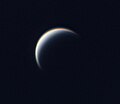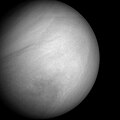Overview

CUVE is a concept mission proposed to NASA that would orbit Venus to measure the ultraviolet light absorption and airglow emissions in order to understand the planet's atmospheric dynamics. [1] [4] [3] CUVE is one of ten proposed missions to study Solar System planets and asteroids, selected by the agency under the Planetary Science Deep Space SmallSat Studies (PSDS3) program, managed by NASA's Science Mission Directorate. [4] The mission was proposed to NASA and it was selected in 2017 for further conceptual development. [5] The team is led by the University of Maryland with collaboration from NASA's Goddard Space Flight Center, the Catholic University of America, and the National Institute for Astrophysics in Italy. [4]
In order to increase launch opportunities CUVE technical requirements are based on reaching Venus as secondary payload of a planetary mission, including missions that are not targeting Venus, or a launch of an Earth-orbiting mission. [3]
Science
The Venusian upper cloud deck, situated at an altitude range 60–70 km, is formed of small droplets comprising a mix of ~80% sulfuric acid (H
2SO
4) and water. About half of the solar energy received by Venus is absorbed in the UV by a still unknown absorber situated at the top of the cloud layer. [3] Because of its vast absorbing power, knowing its nature is very important to understand the overall radiative and thermal balance of the planet and the atmospheric dynamics. [3] [6] Although NASA, Roscosmos, the European Space Agency, and Japan's JAXA have dispatched multiple missions to Venus, the nature of the cloud top absorber has not been established. [1] [6] [7]
As of 2018, some candidate chemical species have been proposed to explain the spectral contrast features in the UV: SO2, FeCl3, Cl2, Sn, SCl2, S2O, elemental sulfur, and disulfur dioxide (S
2O
2). [6] [8] It has also been speculated that any hypothetical microorganisms inhabiting the upper atmosphere, if present, could employ ultraviolet light emitted by the Sun as an energy source, and could cause the observed UV absorption. [9] [10] [11]



